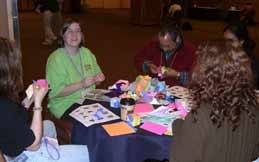
Highlights of the 2005 Joint Mathematics Meetings
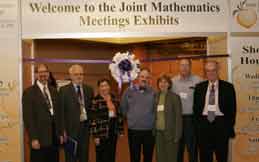
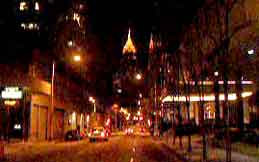
The 2005 Joint Mathematics Meetings of the American Mathematical Society (AMS) and Mathematical Association of America (MAA) were held in Atlanta, Georgia, January 5-8. There were nearly 5,000 participants--mathematicians, exhibitors, employers, and students--who attended invited addresses, special sessions, mini-courses, the prize ceremony, exhibits, contributed paper sessions, and poster sessions. The meetings provided many opportunities for attendees to meet with colleagues old and new, at receptions, meetings and informal gatherings.
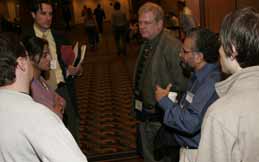
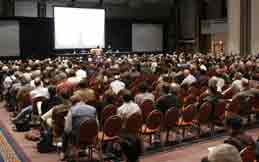
Below are some of the many highlights:
- Is It a Proof Yet? - an AMS Panel Discussion organized by Allyn Jackson
- Continuum Hypothesis: Alive and Well - "The Continuum Hypothesis Revisited," an AMS-ASL Panel Discussion moderated by Keith Devlin
- Origami, Linkages, and Polyhedra: Folding with Algorithms - an MAA Invited Address by Erik D. Demaine
- How "Hardness" Relates to "Randomness" - "The Power and Weakness of Randomness (when you are short of time)," an AMS Invited Address by Avi Wigderson
- Algebraic Statistics - an AMS-MAA Invited Address by Bernd Sturmfels
- Taking Hilbert's 10th Problem a Step Further - "Extensions of Hilbert's Tenth Problem," an ASL Invited Address by Bjorn Poonen
- Poincaré Proof Puzzle - an AMS Invited Address by Bruce A. Kleiner
- Tubular Transport - "New Methods in Celestial Mechanics and Mission Design," by Jerrold Marsden
- The Notices Celebrates a Milestone
- The Graph Theory of Blackwork Embroidery, by Joshua Holden - AMS Special Session on Mathematics and Mathematics Education in Fiber Arts
- The Mathematical Sciences Employment Center
- Prizes and Awards
- Mathematical Art Exhibit - organized by Robert Fathauer, Nat Friedman and Reza Sarhangi
- A Walk on the Industry Side: A Mathematician Takes on the Seismic Exploration Business, by Nicholas Coult - an MAA Session on Mathematics Experiences in Business, Industry, and Government
- Who Wants to be a Mathematician - a game for high school students organized by the AMS Public Awareness Office and Bill Butterworth
- Optimizing Distribution of Power During a Cycling Time Trial, by Michael Scott Gordon - an MAA Session on Mathematics and Sports
- The Exhibits
- Using Mathematically Rich Activities to Develop K-12 Curricula, Part I - an MAA Special Presentation
- AMS Banquet
- AMS Department Chairs Workshop
 The panel discussion organized by Keith Devlin of Stanford University, showed that this longstanding conundrum is still a compelling question for today's mathematicians. The panelists were Paul Cohen of Stanford University, Donald Martin of UCLA, and Hugh Woodin of UC Berkeley. The Continuum Hypothesis (CH) is a statement about the cardinality of infinite sets. Call the cardinality of the set of integers A0 and the cardinality of the set of real numbers A1. Then CH asserts that there is no cardinal number between A0 and A1. Cohen, now 70 years old, received the Fields Medal in 1966 for showing that CH is independent of the Zermelo-Frankel axioms of set theory. CH is therefore undecidable in Zermelo-Frankel set theory. But could additional axioms be added that would allow for a proof of CH? To date, no one has come up with such axioms, but recent work of Woodin seems to move in this direction. If such axioms are found, would they be as simple, clear, and natural as the Zermelo-Frankel axioms?
The panel discussion organized by Keith Devlin of Stanford University, showed that this longstanding conundrum is still a compelling question for today's mathematicians. The panelists were Paul Cohen of Stanford University, Donald Martin of UCLA, and Hugh Woodin of UC Berkeley. The Continuum Hypothesis (CH) is a statement about the cardinality of infinite sets. Call the cardinality of the set of integers A0 and the cardinality of the set of real numbers A1. Then CH asserts that there is no cardinal number between A0 and A1. Cohen, now 70 years old, received the Fields Medal in 1966 for showing that CH is independent of the Zermelo-Frankel axioms of set theory. CH is therefore undecidable in Zermelo-Frankel set theory. But could additional axioms be added that would allow for a proof of CH? To date, no one has come up with such axioms, but recent work of Woodin seems to move in this direction. If such axioms are found, would they be as simple, clear, and natural as the Zermelo-Frankel axioms?
Demaine then turned his attention to paper folding and unfolding. After showing a few slides of recent origami art, he discussed some work being done in the young field of "origami mathematics." For example, the silhouette problem: Is every two-dimensional shape made of straight sides the silhouette of a flat origami? has been answered (the answer is yes, given a sufficiently large piece of paper) but the question of what is the largest regular tetrahedron (or octahedron, dodecahedron, or icosahedron) that can be folded from a unit square remains open. After discussing different methods of paper folding, Demaine next talked about paper cutting, demonstrating--and entertaining the audience--by folding a piece of paper, making a complete straight cut in it, and displaying the resulting cut-out shapes (including a star and a butterfly). He followed this with a discussion of map folding and concluded his talk with the subject of polyhedron unfolding, demonstrating with a video how a folded Latin cross could be made into various three-dimensional shapes, in addition to a cube. For further information, go to Erik Demaine?s webpage on folding.
— Claudia Clark, freelance science writer and former AMS-AAAS Mass Media Fellow
In his invited address entitled "The Power and Weakness of Randomness (when you are short of time)," Avi Wigderson of the Institute for Advanced Study touched on some of the deepest and most mysterious questions in theoretical computer science today. Efficient algorithms exist to solve many real-world problems on computers. Here an efficient algorithm is one whose running time increases as a polynomial function of the size of the problem. By introducing randomness into the algorithm, one can improve the running time but one must pay the price of a small possible error in the answer. This error can be made as small as one likes. A simple example: Suppose you want to know if a polynomial expression is identically zero. The running time for simplifying the expression could be an exponential function of the size of the expression. So choose a point at random, plug it into the expression, and if you get zero, the expression is probably identically zero. You can improve the accuracy by plugging in more points. Wigderson presented a number of problems in which such probabilistic algorithms work well. He then posed a question: Are there problems for which an efficient probabilistic algorithm can be found, but for which no deterministic algorithm exists? No one knows for sure. Likewise, no one knows the answer to the famous P versus NP problem, which asks, Are there problems for which an exponential-time algorithm exists but no polynomial-time algorithm exists? One of the great achievements of theoretical computer science, Wigderson said, is the surprising fact that the answers to these two questions cannot both be "yes." If there is at least one problem that is truly hard, then efficient probabilistic algorithms, for any problem, can always be replaced by efficient deterministic ones. This achievement requires a new understanding of the age-old notion of "randomness."
— Allyn Jackson, Senior Writer and Deputy Editor of The Notices of the AMS
Algebraic Statistics - AMS-MAA Invited Address by Bernd Sturmfels
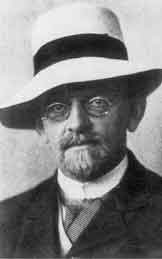 Hilbert's 10th problem appeared on the famous list of 23 outstanding mathematics problems proposed by David Hilbert in 1900. The 10th problem was to find a mechanical procedure for deciding the solvability of any Diophantine equation--that is, for deciding whether a polynomial equation with integer coefficients and any number of variables has a solution in integers. That no such procedure exists was proved in 1970 by Yuri Matiyasevich, using work of Julia Robinson, Martin Davis, and Hilary Putnam.
Hilbert's 10th problem appeared on the famous list of 23 outstanding mathematics problems proposed by David Hilbert in 1900. The 10th problem was to find a mechanical procedure for deciding the solvability of any Diophantine equation--that is, for deciding whether a polynomial equation with integer coefficients and any number of variables has a solution in integers. That no such procedure exists was proved in 1970 by Yuri Matiyasevich, using work of Julia Robinson, Martin Davis, and Hilary Putnam.
In this lecture Bjorn Poonen of UC Berkeley discussed progress on generalizations of the problem. For instance, what happens if the coefficients in the equation, and the coordinates of a solution, are allowed to be in a ring other than the ring of integers Z? For some rings the answer is obvious, for others a bit of work is required, and for still others nothing is known. One ring for which the question is unresolved is the rational numbers Q. Poonen discussed some approaches to the question, such as seeing whether the "no" answer for Z implies a "no" answer for Q. These approaches, if successful, would also disprove a conjecture of Barry Mazur about the topology of rational points on varieties. Poonen has proven that the answer is "no" for a ring that is in some sense "close to" Q, but it is unclear if the method can be generalized to Q itself.
— Allyn Jackson, Senior Writer and Deputy Editor of The Notices of the AMS
Poincaré Proof Puzzle - an AMS Invited Address by Bruce A. Kleiner
Has the Poincaré Conjecture been solved? What about the Thurston Geometrization Conjecture? These questions have been circulating around the mathematical community ever since Grigory Perelmanposted a series of remarkable papers on the web two years ago. Perelman is a mathematician in the Laboratory of Mathematical Physics in the St. Petersburg Branch of the Steklov Institute of Mathematics in Russia. As mathematicians have continued to struggle to understand his difficult and challenging papers, the jury is still out on whether the work is 100 percent correct and complete. In his lecture on Perelman's work, Bruce Kleiner of the University of Michigan shied away from giving a simple "yes" or "no" answer about whether Perelman has succeeded. But Kleiner did provide a clear flowchart for how Perelman's proof proceeds and outlined some of the main ideas involved. Essentially, Perelman has carried out a program proposed in the early 1980s by Richard Hamilton. Hamilton suggested that the Thurston Geometrization Conjecture could be solved using a tool called the Ricci flow. The presence of singularities is a major complication in Hamilton's approach. Perelman successfully implemented a surgery process that "clips off" the singular part of the manifold. Kleiner identified three key phases in Perelman's proof: 1) show that the singularities have a standard form; 2) carry out the flow-with-surgery method; and 3) study the long-time behavior of the flow with surgeries. As experts like Kleiner have worked through Perelman's proof, all the small problems that have arisen have been fixed. While these experts would probably be very surprised if the proof turns out to be wrong, no one is yet clamoring to proclaim it as correct.
— Allyn Jackson, Senior Writer and Deputy Editor of The Notices of the AMS
Tubular Transport - "New Methods in Celestial Mechanics and Mission Design," by Jerrold Marsden
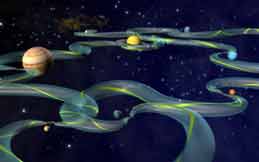
The gorgeous, full-color graphics painted a picture of outer space as filled with "tubes" that function as superhighways weaving around the solar system. Jerrold Marsden of Caltech took his audience on a cosmic journey in his lecture "New Methods in Celestial Mechanics and Mission Design," which reported on work by a group of researchers in the United States and Germany. The central mathematical ideas go back to the great nineteenth century mathematician Henri Poincaré, who did monumental work in celestial mechanics. In particular he studied the three-body problem, a dynamical system in which three massive bodies move under mutual gravitational attraction. In such a system, the tangle of gravitational forces creates tubular passageways in the space between the bodies; these passageways are realized geometrically as invariant manifolds of the dynamical system.
(Image concept by Martin Lo, Jet propulsion laboratory; Graphics by Cici Koenig, Caltech.)
The entire solar system is threaded with these tubes, Marsden explained, and they can be used to transport spacecraft from one planet to another with very little energy. What makes this method so efficient is the use of the unstable orbits of the dynamical system, which Marsden noted are actually very easy for the spacecraft to travel on. (Marsden confessed that he never understood why in the field of dynamical systems so much attention is paid to the stable orbits, while the unstable orbits are so useful and interesting.) These interplanetary transport tubes have been used in previous space missions, such as the Genesis craft that collected solar wind data, and will be used in the Jupiter Icy Moons orbit, to be launched a decade from now.
Marsden's lecture was presented in the AMS Special Session on Current Events, organized by David Eisenbud, AMS president and director of the Mathematical Sciences Research Institute in Berkeley. Talks in the session and speakers are below:
- The Green-Tao Theorem on Primes in Arithmetic Progression: A Dynamical Point of View, Bryna Kra
- Achieving the Shannon Limit: A Progress Report, Robert McEliece
- Floer Theory and Low Dimensional Topology, Dusa McDuff
- New Methods in Celestial Mechanics and Mission Design, Jerrold E. Marsden (Shane D. Ross, co-author)
- Graph Minors and the Proof of Wagner's Conjecture, László Lovász
A booklet (4 MB, pdf) contains all the talks in the session. — Allyn Jackson, Senior Writer and Deputy Editor of The Notices of the AMS
The Notices Celebrates a Milestone
The Notices of the AMS held a special reception to mark the 10th anniversary of its 1995 redesign, which encompassed not only a new look for the publication but also a new editorial vision. At a reception held on the final day of the Joint Mathematics Meetings, Notices editors, staff, and friends celebrated 10 successful years of one of the world's most popular magazines for the professional mathematician. See the January 2005 issue for articles about the Notices anniversary.


— Allyn Jackson, Senior Writer and Deputy Editor of The Notices of the AMS
— Lisa DeKeukelaere, AMS-AAAS Mass Media Fellow
The Mathematical Sciences Employment Center
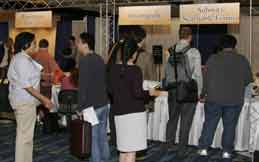

About 120 employers interviewed approximately 550 applicants at the Employment Center; numbers that are similar to those from the previous year. Both the computer-scheduled interview area and employer-scheduled interview area were busy with thousands of interviews being conducted over the three-and-a-half day period the Employment Center was open. A message center helped both groups to communicate about appointments. The Marriott Marquis hotel space used for the Employment Center provided an unusually peaceful and attractive setting, with carpeting and movable walls. Participants appreciated the organizational efforts of AMS staff, led by Colleen Rose.
The Mathematical Sciences Employment Center is held each January at the Joint Mathematics Meetings. The Center provides a service for Ph.D.-level mathematicians seeking employment and for employers, mainly academic, who wish to conduct brief interviews with candidates. Read an Overview of the Employment Center. — Diane Boumenot, Manager of Membership & Programs

The Prizes and Awards booklet (pdf) includes all the AMS, AMS-MAA-SIAM, AWM, JPBM and MAA prizes presented at the 2005 Joint Mathematics Meetings, with citations, as well as brief biographies of and responses from each winner. Shown here is Barry Cipra (right), who received the Communications Award from the Joint Policy Board for Mathematics.
— Annette Emerson, AMS Public Awareness Officer
This mathematical art exhibit of prints and sculptures--the second held at the Joint Mathematics Meetings--was located in the main Exhibits Hall, and included works by Ergun Akleman, Anne Burns, Jason Cantarella and Michael Piatek, Douglas Dunham, Robert Fathauer, Michael Field, Gwen Fisher, Herbert Franke, Bathsheba Grossman, George Hart, Teja Krasek, Piotr Krawczyk, Robert Krawczyk, Eric Landreneau, Ozan Ozener, Irene Rousseau, Carlo Séquin, Clifford Singer, John Sullivan and Mary Williams.
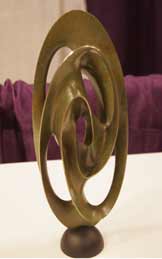
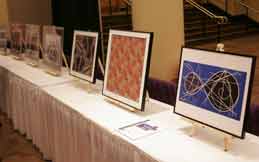
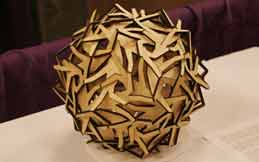

MathArtFun.com has an online exhibit of the works that were on display in Atlanta.
— Annette Emerson, AMS Public Awareness Officer
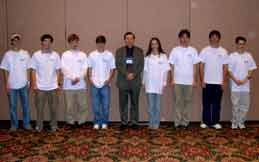

(Note: Dragos Ilas qualified in November at a game held in Georgia, but now lives in Tennessee.)
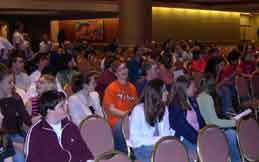

How fast should Lance Armstrong pedal during the downhill stretches of the Tour de France? Michael Scott Gordon presented his answer in a lecture that combined calculus and physics. The power generated by a cyclist traveling at a constant velocity is a function of the drag coefficient, the mass of the rider and the cycle, friction, and the uphill grade. This can be expressed as an equation, the dominating term of which depends on whether the cyclist is traveling uphill or downhill. Thus, it is reasonable to ask whether it is possible to minimize the amount of work required to complete a course in a given amount of time.
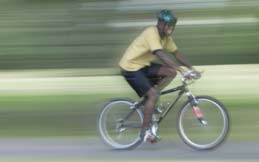

The exhibit hall again provided the sponsoring societies and exhibitors a chance to meet with members, authors and clients, and to display and sell their products and services. Several contributed items for the daily raffles. The hall is also a main gathering place for meeting participants to see colleagues and meet with their publishers. On Wednesday, the opening day of the exhibits, David Eisenbud (AMS president), Bob Daverman (AMS Secretary), John Ewing (AMS Executive Director), Ron Graham (MAA President), Tina Straley (MAA Executive Director), Martha Siegel (MAA Secretary) and Jim Tattersall (MAA Associate Secretary) took part in the ribbon-cutting ceremony at the hall's entrance, after which the meeting attendees streamed in to see the exhibits. This year there were 64 exhibitors: organizations, government agencies, publishers, booksellers, software companies, artists, and gift vendors.
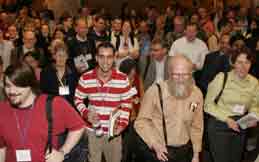

The AMS exhibit included books, Mathematical Reviews® and MathSciNet, an online connection to the AMS Bookstore, a meeting place for AMS authors, and the AMS Membership booth, at which people could learn more about the Society and pick up giveaways such as calendars, the Mathematics Awareness Month poster, postcards, and various materials on AMS programs. The Society also hosted a booth for the Mathematics Genealogy Project.

Benoit Mandelbrot signed Fractal Geometry and Applications: A Jubilee of Benoit Mandelbrot: Multifractals, Probability and Statistical Mechanics, Applications (Michel L. Lapidus and Machiel van Frankenhuijsen, editors) in the AMS exhibit area.


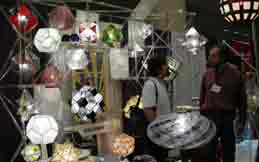
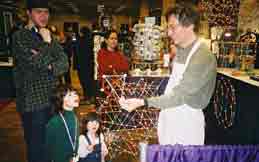
The AMS also hosted a reception for Mathematical Reviews® editors and reviewers, and another for AMS authors. Shown below at the Mathematical Reviews® reception are (left to right) Jane Kister (past Executive Editor of Mathematical Reviews®), David Eisenbud (AMS President) and Carol Hutchins (Head Librarian at the Courant Institute of Mathematical Sciences Library at New York University).
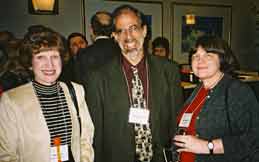
See many more photographs of the exhibits. — Annette Emerson, AMS Public Awareness Officer
Using Mathematically Rich Activities to Develop K-12 Curricula, Part I - an MAA Special Presentation
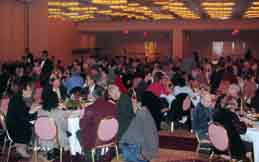

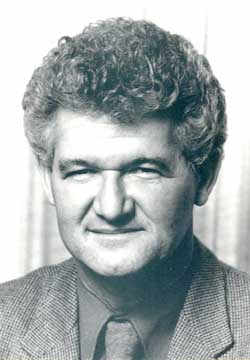 The prize for the longest-term AMS member in attendance was won by Peter Lax, Professor Emeritus of New York University-Courant Institute, who has been an AMS member since 1945.
The prize for the longest-term AMS member in attendance was won by Peter Lax, Professor Emeritus of New York University-Courant Institute, who has been an AMS member since 1945.
— Diane Boumenot, Manager of Membership & Programs
Although the AMS and MAA co-sponsored the joint meetings, several other organizations also held meetings, sponsored prizes, and hosted sessions: the Association for Symbolic Logic, the Association for Women in Mathematics, the National Association of Mathematicians, the National Science Foundation, Pi Mu Epsilon, the Rocky Mountain Mathematics Consortium, the Society for Industrial and Applied Mathematics, and the Young Mathematicians Network. See the complete program.
We look forward to seeing you at next year's Joint Mathematics Meetings in San Antonio, Texas, January 12 - 15, 2006. Note that the meetings will be held Thursday through Sunday.
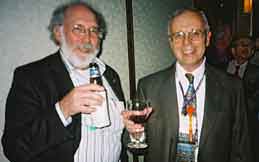
Photos by Diane Boumenot, Mike Breen, Bill Butterworth, Lisa DeKeukelaere, Annette Emerson, Sandy Frost, Allyn Jackson, Michael Reeves, and Norman Richert.
See also: Highlights of the 2004 Joint Mathematics Meetings in Phoenix, Arizona.


